Trees Birds Mammals Fish Amphibians Reptiles
Wild Algarve
Bookshop
Abortiporus biennis (Bull.) Singer - Blushing Rosette
Phylum: Basidiomycota - Class: Agaricomycetes - Order: Polyporales (insertae sedis) - Family: Meruliaceae
Distribution - Taxonomic History - Etymology - Identification - Culinary Notes - Reference Sources
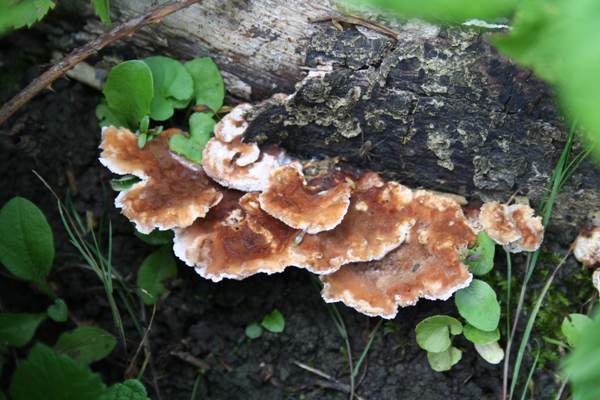
This wood-rotting fungus sometimes forms very attractive rosettes - and some people refer to it as the Blushing Rosette - but more often it grows as an amorphous mass of irregular maze-like pores exuding blobs of red-brown juice that eventually dry to leave brown stains of the pore surface.
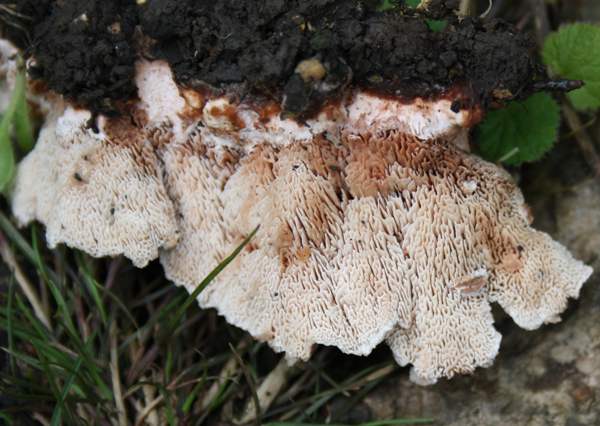
Distribution
Although an infrequent find, this wood-rotting fungus occurs throughout Britain and Ireland as well as in many parts of mainland Europe and North America.
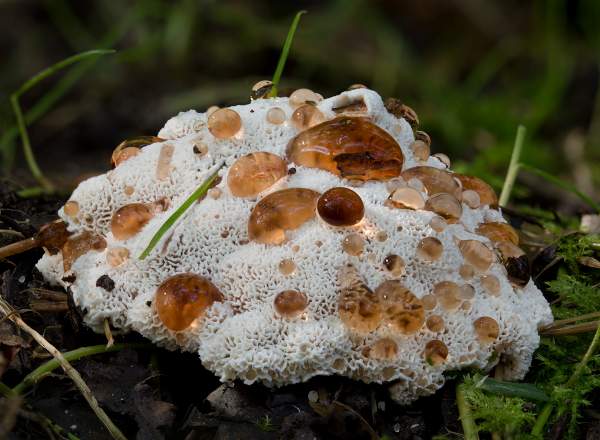
Taxonomic history
In 1789, when French mycologist Jean Baptiste Francois Pierre Bulliard described this species, he gave it the binomial scientific name Boletus biennis. The currently-accepted name Abortiporus biennis dates from a 1944 publication by German-American mycologist Rolf Singer.
Synonyms of Abortiporus biennis include Boletus biennis Bull., Sistotrema bienne (Bull.) Pers., Hydnum bienne (Bull.) Lam. & DC., Daedalea biennis (Bull.) Fr., Polyporus biennis (Bull.) Fr., and Phaeolus biennis (Bull.) Pilát.
Abortiporus biennis is the type species of the genus Abortiporus, which contains just three species.
Etymology
Abortiporus, the genus name, comes from the Latin Abortus- meaning arrested development (of an organism), and -porus, derived from ancient Greek and meaning a pore. The specific epithet biennis means biennial (although the fruitbodies of this fungus are annual!)
Identification guide
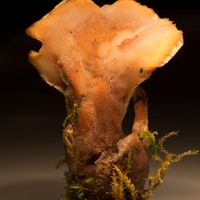 |
Infertile upper surface (when in rosette or fan form)
Typically 10 to 15cm across and up to 1cm thick tomentose, pale pinkish to reddish brown, sometimes faintly zoned; stem may be absent or rooting and up to 5cm long and up to 3cm in diameter.
Note: aberrant forms commonly occur. They can be either hemispherical or irregular in shape with several blobs coalescing, the entire visible surface being fertile - see below. |
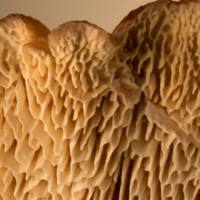 |
Fertile surface (underside when inrosette or fan form; upperside when amorphous or in 'cauliflower' form)
Covered in white or buff angular pores 1 to 3 per mm, becoming irregularly labyrithine (reminiscent of Daedalea quercina) and reddish brown in mature specimens; often exuding reddish-brown droplets. Surface bruises red-brown when touched. Tubes are 2 to 5mm long.
In fan/rosette fruitbodies with stems, the pores are decurrent to the stem and severl stems may be joined at the base.. |
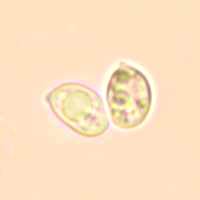 |
Spores
Broadly ellipsoidal to ovoid, thin-walled, with oil drops, smooth, 4.5-6.5 x 4-5µm; inamyloid.
Spore print
Creamy yellow. |
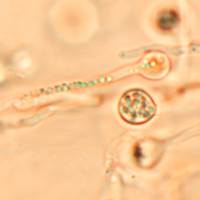 |
Chlamydospores
Chlamydospores, present in the context of the fruitbody, are globose, thick-walled, smooth, 5-9µm across.
|
Odour/taste |
Not significant. |
Habitat & Ecological role |
Saprobic emerging in grass or soil from dead parts of the roots of broadleaf trees, often around stumps; also occasionally on woodchip mulch. |
Season |
Autumn. |
Similar species |
Could be confused with the Sheep Polypore Albatrellus ovinus, which has a white or creamy yellow pore surface with tiny mostly oval pores that never become labyrinthine. |
Culinary Notes
This fungus is generally regarded as inedible.
Reference Sources
Abortiporus Murrill, Bulletin of the Torrey Botanical Club 31 (8): 421 (1904).
Fascinated by Fungi, 2nd Edition, Pat O'Reilly 2016, reprinted by Coch-y-bonddu Books in 2022.
Dictionary of the Fungi; Paul M. Kirk, Paul F. Cannon, David W. Minter and J. A. Stalpers; CABI, 2008
Taxonomic history and synonym information on these pages is drawn from many sources but in particular from the British Mycological Society's GB Checklist of Fungi and (for basidiomycetes) from Kew's Checklist of the British & Irish Basidiomycota.
Acknowledgement
This page includes pictures kindly contributed by Simon Harding and David Kelly.
Top of page...
Fascinated by Fungi. Back by popular demand, Pat O'Reilly's best-selling 450-page hardback book is available now. The latest second edition was republished with a sparkling new cover design in September 2022 by Coch-y-Bonddu Books. Full details and copies are available from the publisher's online bookshop...